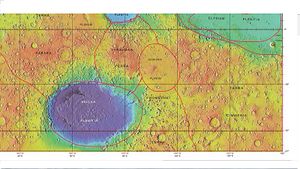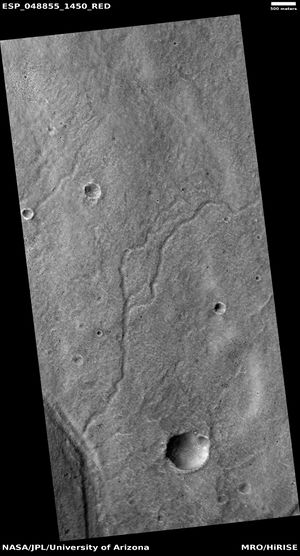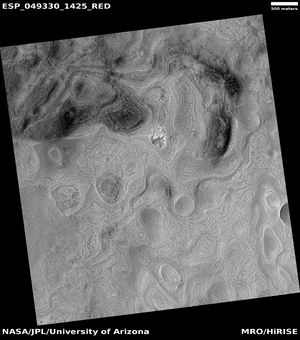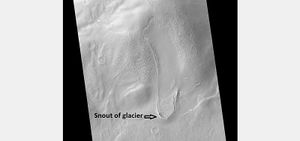Difference between revisions of "Hellas Planitia"
(added information on location) |
(added information) |
||
| Line 5: | Line 5: | ||
'''Hellas Planitia''' is a vast [[meteorites|meteorite]] impact basin located at 42° 42'S 70° 00'E, in the [[Mars]] southern hemisphere. Hellas Planitia is in the Hellas quadrangle and the Noachis quadrangle. | '''Hellas Planitia''' is a vast [[meteorites|meteorite]] impact basin located at 42° 42'S 70° 00'E, in the [[Mars]] southern hemisphere. Hellas Planitia is in the Hellas quadrangle and the Noachis quadrangle. | ||
Also known as the '''Hellas Impact Basin''', this landmark has a very obvious impact [[crater]] ring 2,300 km (1,400 mi) in diameter. This is one of the largest known impact craters in the [[solar system]].<ref>[http://en.wikipedia.org/wiki/Hellas_Basin Hellas Basin article on Wikipedia]</ref><ref>[http://en.wikipedia.org/wiki/Impact_crater#Largest_named_craters_in_the_Solar_System Impact Craters on Wikipedia]</ref> | Also known as the '''Hellas Impact Basin''', this landmark has a very obvious impact [[crater]] ring 2,300 km (1,400 mi) in diameter. This is one of the largest known impact craters in the [[solar system]].<ref>[http://en.wikipedia.org/wiki/Hellas_Basin Hellas Basin article on Wikipedia]</ref><ref>[http://en.wikipedia.org/wiki/Impact_crater#Largest_named_craters_in_the_Solar_System Impact Craters on Wikipedia]</ref> | ||
| + | |||
| + | Radar images by the Mars Reconnaissance Orbiter (MRO) spacecraft's SHARAD radar sounder suggest that features called lobate debris aprons in at least some craters in the eastern region of Hellas Planitia are actually glaciers of water ice lying buried beneath thin layers of dirt and rock.<ref name="Nasa">{{cite web|url=http://photojournal.jpl.nasa.gov/catalog/?IDNumber=pia11433|title=PIA11433: Three Craters|accessdate=2008-11-24|author=NASA}}</ref> Scientists believe that snow and ice accumulated on higher topography, flowed downhill, and is now protected from sublimation by a layer of rock debris and dust. Sublimation is when a solid changes directly to a gas without passing through a liquid phase. So on Mars, water ice will go directly into a vapor phase. This is common on Mars because of its thin atmosphere. Furrows and ridges on the surface were caused by deforming ice. | ||
| + | |||
| + | Also, the shapes of many features in Hellas Planitia and other parts of Mars are strongly suggestive of glaciers, as the surface looks as if movement has taken place. | ||
| + | |||
[[Image: ESP 048855 1450channels.jpg|right|thumb|300px|Channels in Hellas quadrangle]] | [[Image: ESP 048855 1450channels.jpg|right|thumb|300px|Channels in Hellas quadrangle]] | ||
Revision as of 10:36, 8 February 2018

Hellas Planitia is a vast meteorite impact basin located at 42° 42'S 70° 00'E, in the Mars southern hemisphere. Hellas Planitia is in the Hellas quadrangle and the Noachis quadrangle. Also known as the Hellas Impact Basin, this landmark has a very obvious impact crater ring 2,300 km (1,400 mi) in diameter. This is one of the largest known impact craters in the solar system.[1][2]
Radar images by the Mars Reconnaissance Orbiter (MRO) spacecraft's SHARAD radar sounder suggest that features called lobate debris aprons in at least some craters in the eastern region of Hellas Planitia are actually glaciers of water ice lying buried beneath thin layers of dirt and rock.[3] Scientists believe that snow and ice accumulated on higher topography, flowed downhill, and is now protected from sublimation by a layer of rock debris and dust. Sublimation is when a solid changes directly to a gas without passing through a liquid phase. So on Mars, water ice will go directly into a vapor phase. This is common on Mars because of its thin atmosphere. Furrows and ridges on the surface were caused by deforming ice.
Also, the shapes of many features in Hellas Planitia and other parts of Mars are strongly suggestive of glaciers, as the surface looks as if movement has taken place.
References:
| This article is a stub. You can help Marspedia by expanding it. |










